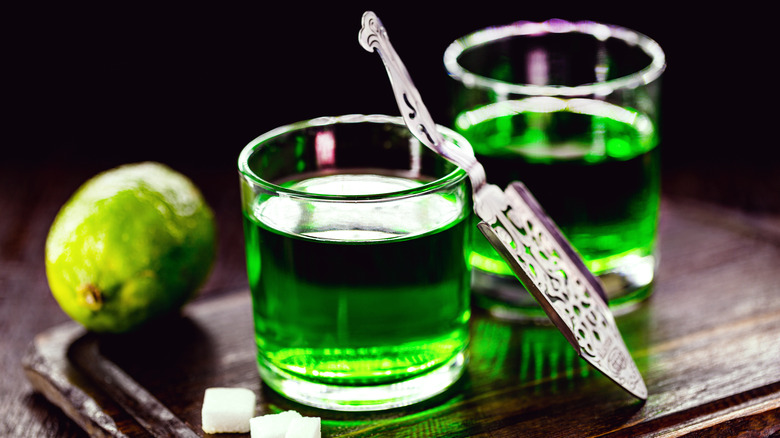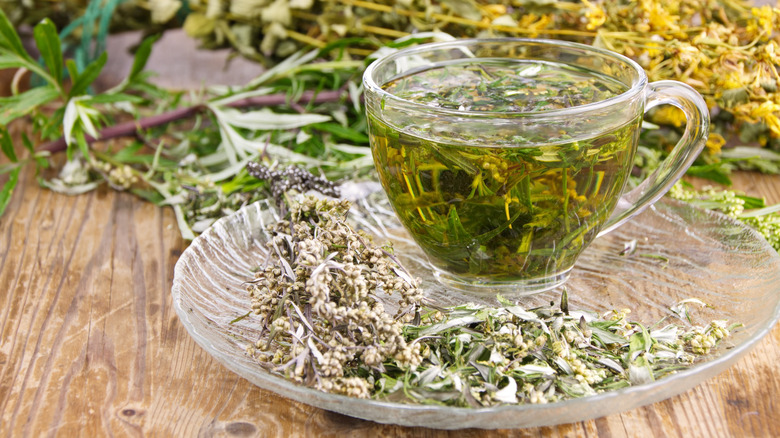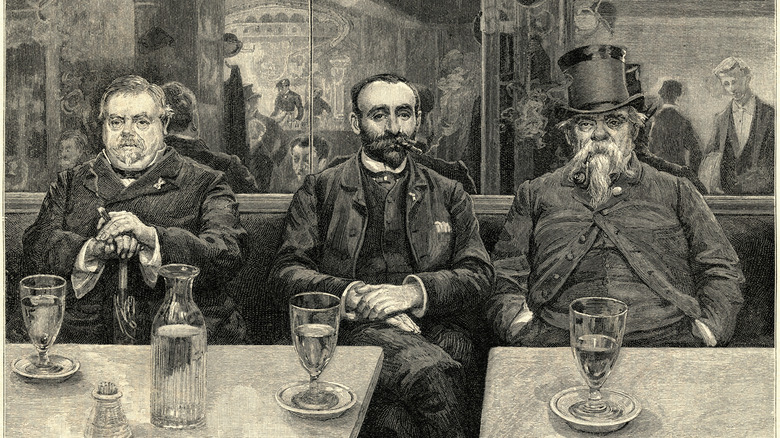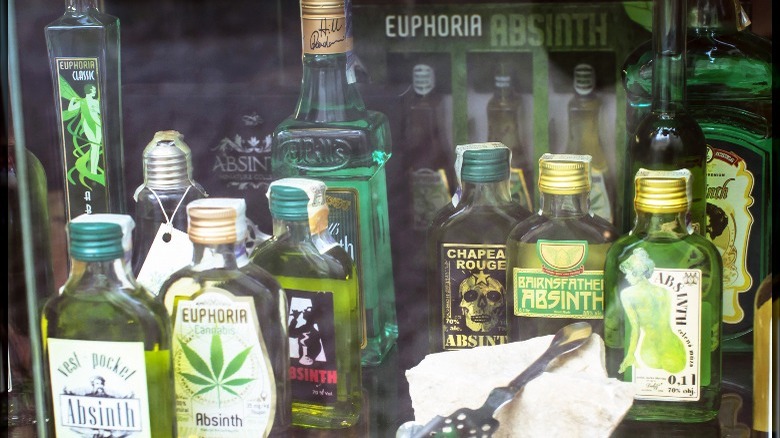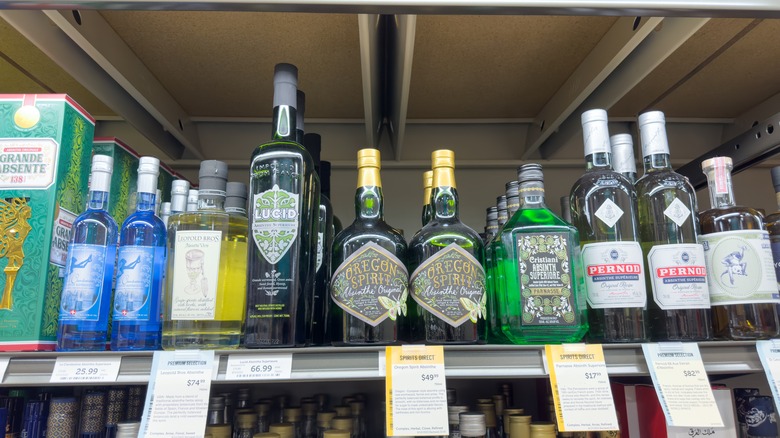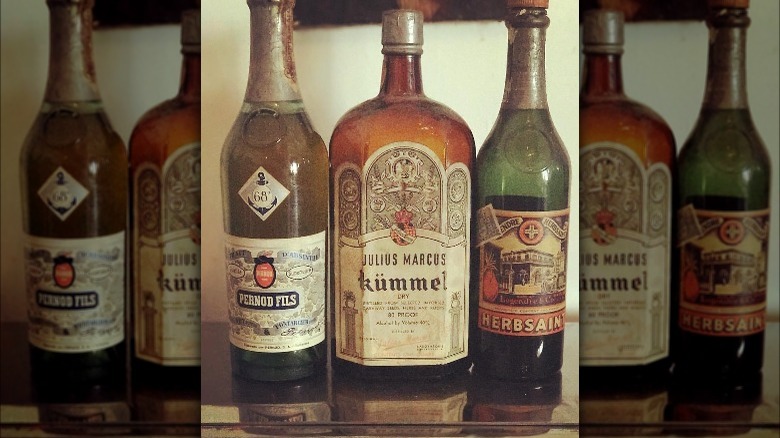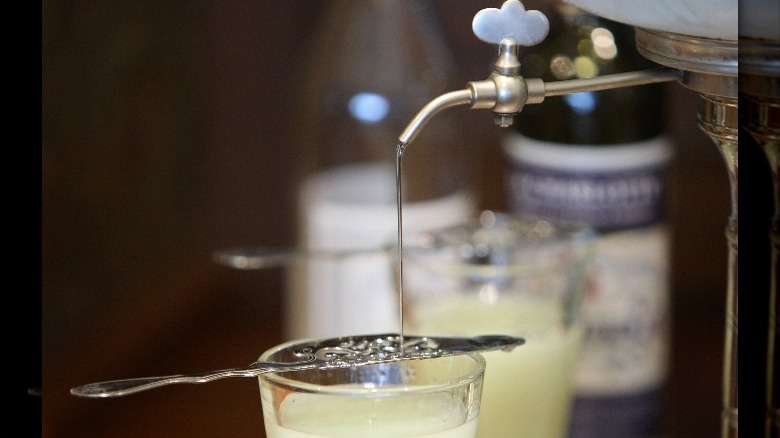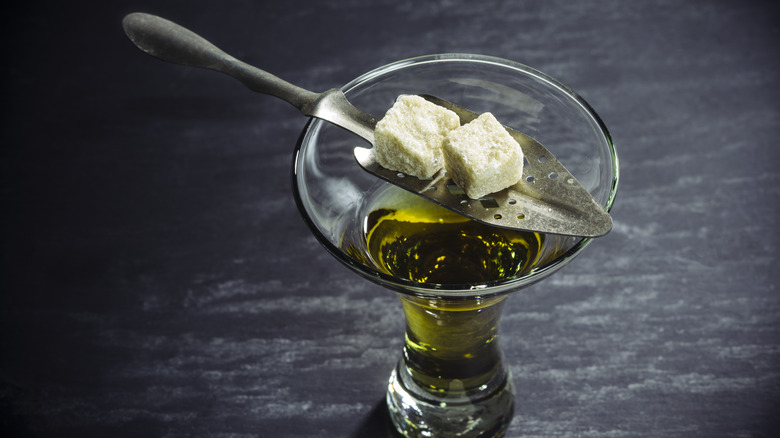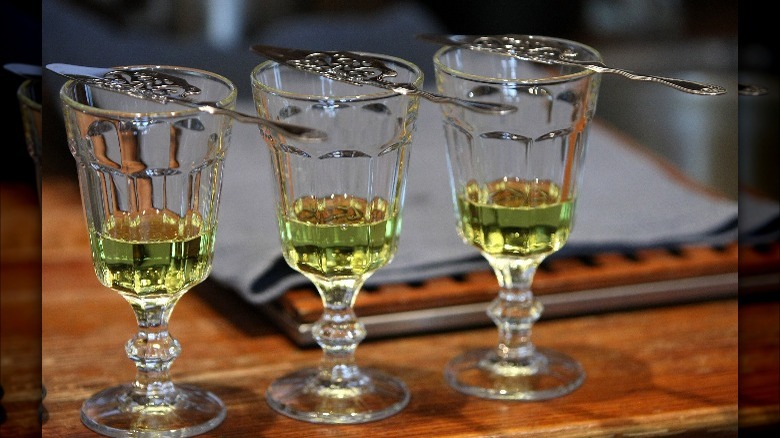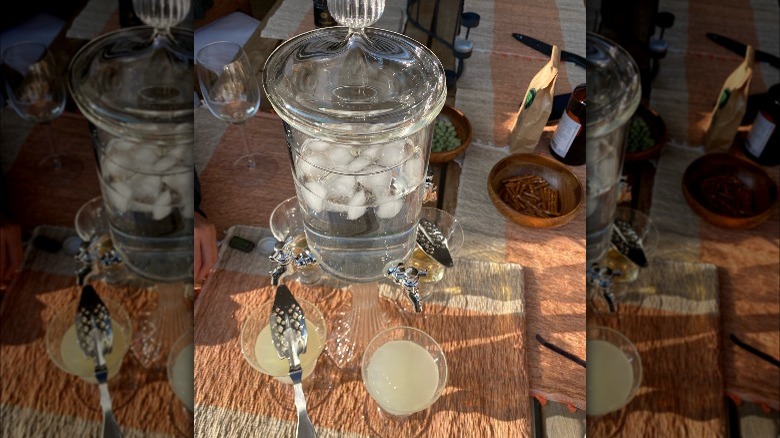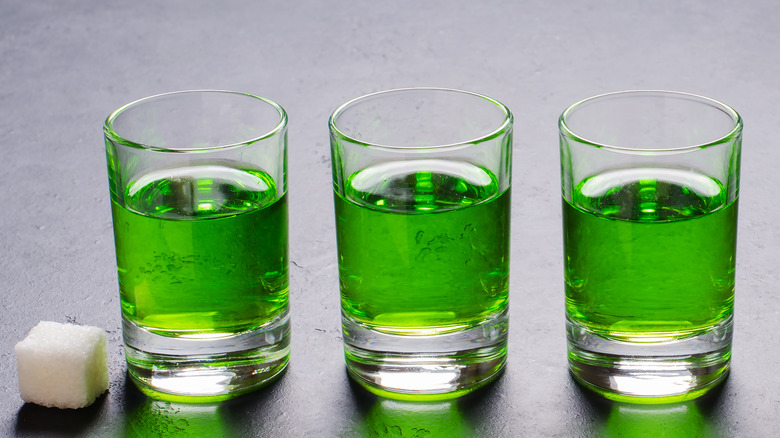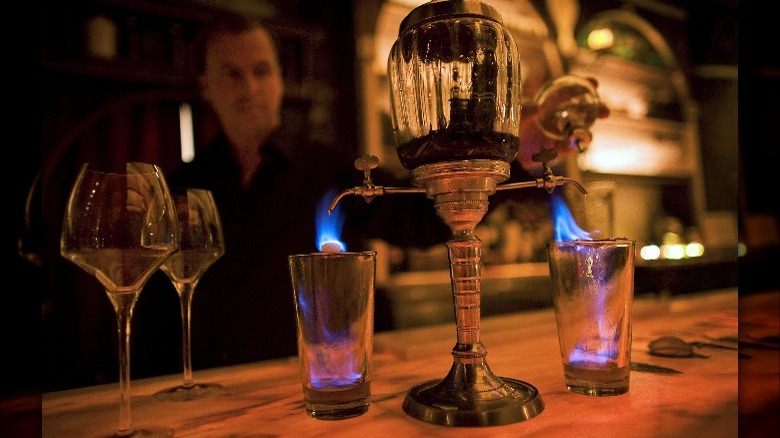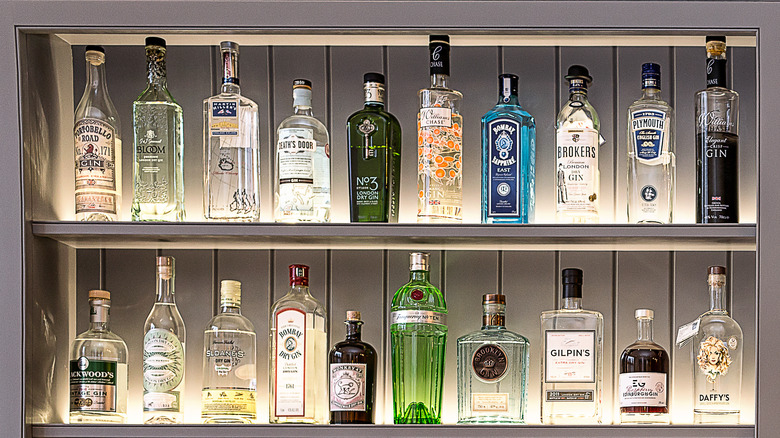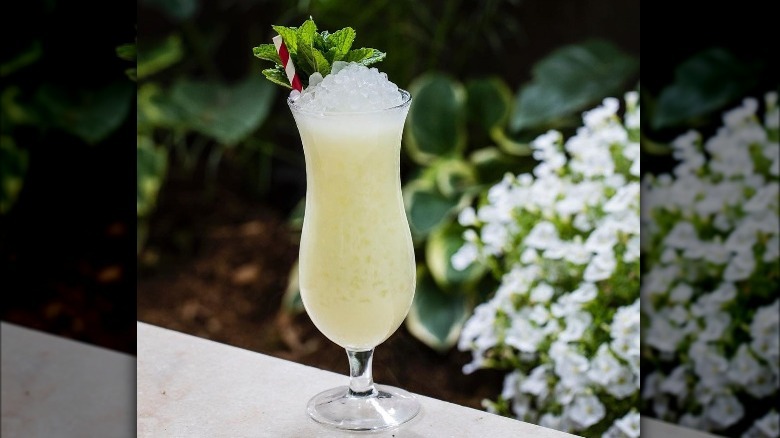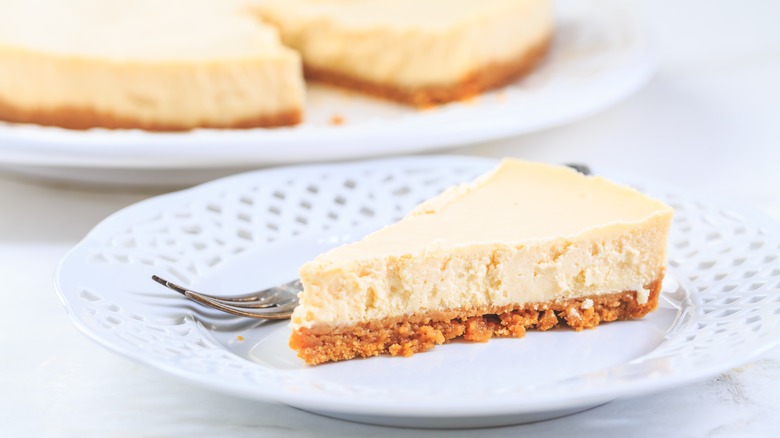14 Important Facts To Know About Absinthe
We may receive a commission on purchases made from links.
Ever go out for a night on the town specifically to hit the hot new bar that's devoted to your favorite liquor or cocktail? Gin bars, whiskey bars, and tequila bars dot cities all over the world. But with cocktails becoming increasingly complex and bartenders committed to creating unique ways to upgrade your martini or margarita, watering holes are no longer just dedicated to the classic white and brown liquors. Now you can find shops devoted to the lesser spirits like Campari, vermouth, and absinthe.
While you may think that you can only experience absinthe in France or New Orleans, there's a little bar in Brooklyn that's dedicated to not only serving the bright green elixir but educating its patrons about it. Want to enjoy it in a cocktail? Maison Premiere has several to choose from. Not sure about the liquor and want to try it straight? Maison has 20 to 30 different varieties at any given time.
If you just can't get out to New York and still want a taste, Maison has just released "The Maison Premiere Almanac," a book that thoroughly examines absinthe and the bar itself. But before you pore over its stunning pages, co-owner Joshua Boissy and bar director William Elliott gave us a thorough lesson on the liquor, where it came from, and how to use it.
Absinthe is made up of three ingredients
Absinthe is such an interesting name for liquor, but it wasn't just created out of thin air. The name "absinthe" actually comes from the Latin Artemisia absinthium, which is the plant more commonly known as wormwood. The wormwood plant is made up of clusters of yellow flowers and grayish-green leaves and has long been used as flavorings for teas and medicinal agents.
Unfortunately, on its own, wormwood is quite bitter tasting. People discovered it would be more appetizing if it was mixed with two other herbs: fennel and anise. Those plants not only sweetened up the wormwood but also gave the liquor its distinct licorice flavor. Once the medicinal wormwood was distilled and palatable, other botanicals were added to the liquid in order to further enhance various tonics and give the liquid its bright green color.
The history of absinthe
If you lived in France in the early nineteenth century, odds are you often enjoyed a drink at an outdoor café. The drink of choice? Absinthe. Usually imbibed during the green hour from five to seven, according to the "Maison Premiere Almanac," it's what everyone drank whether you were a journalist, businessman, naval officer, or poet. The green hour got its name thanks to the inordinate amount of green liquid gracing tables all over the city.
Absinthe didn't start out as a delightful aperitif. Boissy says that the liqueur actually began its storied history thanks to Pierre Ordinaire. He created tasty absinthe tonics as a means to fix whatever was ailing his patients. After Ordinaire's death, his recipe ended up in the hands of a man named Henri Louis Pernod, who began distilling it commercially, turning Pernod into the largest absinthe company in the world where the liquor continues to be produced today.
As the years progressed, absinthe's popularity grew, and by the mid-1800s, there wasn't a café in France that didn't stock a bottle. Unfortunately, the rise of absinthe meant that other liquors, like wine and whiskey, fell by the wayside. So, absinthe started getting a dark reputation that Boissy says was purported by those unhappy winemakers. That reputation, coupled with a gruesome 1905 murder blamed on the spirit, caused absinthe to be banned, and by 1914 nary a bottle could be found.
There's not much difference between the absinthe of the 1800s and the absinthe of today
While the world went without absinthe for more than nine decades, it did return. Boissy says we have Ted Breaux, a chemist from New Orleans, to thank for the legalization of the spirit here in the United States. Thanks to the analysis of some hundred-year-old samples, he proved that someone would have to consume the liquor in extremely large quantities before any negative effects would occur.
Once Breaux got the ban overturned, he started making absinthe with the original equipment, botanicals, and base spirit the pre-ban absinthe used and introduced the world to Lucid, a modern-day version that Boissy says is pretty similar to the original. "People's technique changes and improves, but it's fundamentally the same recipe," he explains. "People believe that 'oh, there's absinthe now, but it's not the real absinthe.' And it's like, 'Oh no. It is absolutely the real absinthe.' The problem is that everyone believes that absinthe makes you hallucinate, and so if it doesn't make you hallucinate, then it's not the real stuff, and that's just not true."
Pernod and absinthe are not the same
Pernod is often referred to in cocktail recipes that call for absinthe. While they may taste similar, they are not the same liquor. Boissy tells us that the two are often confused because Pernod was the first absinthe distiller in the early-1800s. But once absinthe was banned, Boissy says Pernod had to change gears, and the distiller went from making absinthe to making pastis, a French Aperitif.
A lower-proofed anise-flavored liquor, pastis is made with fennel and anise but no wormwood. Boissy explains that it was served in smaller volumes, about ¾ of an ounce to 1 ounce. "Pernod thought, 'We have to differentiate from absinthe,'" he says. "They had to create their own experience. There's no drip or sugar cube. It's now an aperitif." And as an aperitif, the masses could continue enjoying the same flavors they had come to know through absinthe without the fear of hallucination or insanity.
Absinthe comes in three colors
When we think of absinthe, that bright green tipple springs to mind. But these days, green is no longer the only color available. It may be the most common option, but there is also white and even a blue version. Boissy says that the color has a lot to do with how the liquor is made.
If you want an absinthe with more fennel or anise flavor, Boissy recommends the blanche (white). After only one distillation, the clear absinthe is immediately bottled and shipped out. If you're looking for something darker, earthier, and has a bitter bite to it, then the verte (or green) is the one you want. This time, several herbs are added to the freshly-distilled liquor, boosting its color and character. Boissy believes that the second maceration gives the green absinthe more body and flavor. He warns us to stay away from the bright green bottles because, more often than not, that color is the work of artificial coloring agents.
Then there's the blue absinthe. This variation is less common than the other two, but its color completely depends upon the variety of wormwood used in the distillation process. There are wormwood fields in Switzerland that Boissy says have a blue tint, and that's where the color comes from.
Water has a distinct effect on the liquor
There may be hundreds of ways to enjoy a spirit, but there are really only two when it comes to absinthe: as a cocktail or with water. But if you really want to taste the absinthe, drink it with plenty of water. While you could just add water, Boissy admits drinking absinthe is as much about the flavor as it is about the adventure. And that adventure includes an absinthe fountain.
At Maison Premiere, they believe in slowing down and enjoying "the beauty of the ritual," which is why they created the absinthe drip service. 1-1/4 ounces of absinthe are poured into a Pontarlier glass, placed under the fountain, turned on, and the magic starts. "The water hits the absinthe, and then all the oils and the essence of the absinthe are triggered, which creates this reaction which is called the louche," explains Boissy. As the water drips into the absinthe the liquor slowly goes from clear to a milky white. "If you were to just drink absinthe straight, you would find that the flavors and the aromas are going to be subdued in many ways. So, the absinthe louche is critical because that slow drip is basically agitating the spirit and waking it up," he says.
Why do we add a sugar cube?
One of the most well-known absinthe rituals is placing a sugar cube on an ornate spoon and then watching it dissolve as the water drips through it into the glass. By doing this, you're accomplishing two things: diluting the absinthe and sweetening it up. Adding sugar during the 19th century was essential when drinking absinthe because the absinthe of this time tended to have a very bitter flavor from the wormwood. "The sugar made it more palatable," explains Boissy.
But that was then. "Today absinthe is much better so it's not as necessary," Boissy says. The sugar cube isn't even a part of Maison Premiere's drip service. It's optional. "We always ask," he says. Boissy believes that adding the sugar cube softens the blow of the liquor. You can't add it after the drip is done because the sugar won't dissolve correctly. If you want the sugar, it has to be part of the process from the beginning. "We always tell the customer to try it once with it, then try it without."
Absinthe is best enjoyed in special glassware
Part of what makes imbibing absinthe so special is the glassware in which it's served. You could indeed drink it out of a rocks glass or even a wine glass. But if you want to drink it the way they did at the turn of the century, then a Pontarlier glass from Pontarlier, France (where the original absinthe distilleries were located) is the only way to go. Boissy says that even though the Pontarlier is the "oldest and most historic" version of the glass, there are all different styles. "They all have a base and a tall body to it," Boissy explains. But according to Alandia, the glass should "have a reservoir in the stem to measure the correct amount of absinthe for one serving."
At Maison Premiere, Boissy and his partner, Krystof Zizka, chose to have their Pontarlier glasses made special. Each glass has the classic round, heavy base and a tall body, but then it's etched with the Maison Premiere logo. While Boissy says the glass definitely helps with the presentation, it's "most important to know the measurements: 1-1/4 ounces of absinthe and five parts water. The glass doesn't matter."
Other tools are necessary when drinking absinthe
The Pontarlier glass is only part of the event. In order to achieve the full turn-of-the-century experience, you should also have an absinthe fountain, spoon, and saucer. The fountain slowly siphons the necessary amount of water into the absinthe and is the best way to dilute the spirit.
The spoon is not only stunning to behold; it's the perfect shape to hold a sugar cube. While some are long and thin and others are short and fat, each spoon has ornate holes cut through it to allow the water and sugar to drip into the glass. Afraid these elegant utensils are out of your price range? Boissy says that "for $20, you can buy what you need to make absinthe at home."
Finally, there's the saucer. While most drinks these days are simply served in a glass with a napkin on the side, absinthe is still served atop a saucer. See, back in the day, that's how the French would keep track of their patrons' tabs. Each saucer was marked with the cost of a glass of absinthe. The number of saucers stacked on the customer's table was the total cost of his bill. Maison Premiere has continued this tradition. While the price is no longer etched on the plate due to the varying costs of each bottle, the stack of saucers remains.
You don't have to use the classic tools to enjoy a glass of absinthe
Even though part of the absinthe-drinking experience comes with the right tools, you don't have to buy all the equipment we mentioned. In fact, you might already have everything you need right in your kitchen. Yes, a Pontarlier glass is more elegant, but Boissy says a wine glass works just as well. And, while it's true, a stunning absinthe spoon will only run you about $10 on Amazon. A plain old fork will work in a pinch if you'd rather spend that money elsewhere. Boissy says he's even seen people use a small strainer like the bartenders use.
Then there's the absinthe drip. Need the space or desire to buy a fountain? You could do it yourself, but you have to do it slowly, drop by drop, and that's a talent few possess. For this reason, "The Maison Premiere Almanac" suggests using either an eye dropper, turkey baster, or something a little more elegant, a vintage wine decanter with a pour-spout. "These antiques are neither uncommon nor expensive and make for beautiful additions to the absinthe ritual."
Never set absinthe on fire
One of the classic ways absinthe used to be served was all aflame. But co-owner Joshua Boissy strongly advises against that. "Setting it on fire was for spectacle," he says. At Maison Premiere, they're so against the ritual the staff won't even do it if a customer requests it.
Boissy says the fad, known as the Bohemian method, is a relatively new one, created about 40 years ago in the 80s. It supposedly started in Prague and Czechoslovakia, where they were serving shoddy absinthe. Absinthe was maybe below the level, and quality Boissy and his staff serve at Maison Premiere.
Created by dousing the sugar cube in a high-proof spirit and then lighting it on fire, the flaming cube would dissolve and drip into the glass setting the whole drink aflame. So, instead of being mesmerized by the classic louche that happens as the absinthe turns opaque, patrons would be entertained as their green elixir goes up in flames. Boissy doesn't understand the motivation behind this spectacle, as it's not historically accurate and ruins the drink. "It's disgusting," he exclaims. "It will destroy the flavor."
These are the best liquors to pair with absinthe
Even though Boissy and his staff love to serve absinthe the old-fashioned way with water and maybe a sugar cube, they know that not everyone prefers it that way and maybe doesn't prefer it at all. It's for this reason that Maison Premiere has a fully stocked bar, complete with everything from bourbon to tequila. But if you're curious about absinthe and want to try it in a cocktail before you taste it straight, William Elliott, Maison's bar director, knows just the liquor to pair with it.
"I think it most easily slides into other botanical spirit-driven cocktails. So, of course, chief amongst them would be gin," Elliott says. "It would also work well with other, more neutral-spirit cocktails like vodka, you know, shochu, pisco even. So, all of those, I think could work really well," he explains. But absinthe also "plays equally well with citrus," Elliott adds.
Cocktails you can make with absinthe
Since Maison Premiere has a full bar, they can mix up a variety of cocktails. But because the bar is known for its range of absinthe, there are always at least nine absinthe cocktails on its menu at any given time. These cocktails include classics like the Sazerac and Obituary, but there are also some totally unique drinks like the Absinthe Colada and Walcott Express.
Joshua Boissy admits that the Colada may not be the most creative cocktail on their menu. "But people know it," he says. "It's just really delicious. It's not offensive." He sees the Colada as a great gateway into absinthe. "The most important thing is not turning them off," Boissy explains. "The Colada is so friendly. It's not about us forcing the absinthe on you. I would rather more people love it than hate it."
Then there's the Walcott Express, a drink Elliott thinks "deserves a shoutout." It's "essentially a gimlet" that replaces the standard gin with a pine-based spirit called Sapin. What Elliott finds most interesting about this drink is that, unlike other cocktails that use only a sprig of mint, the Express is shaken vigorously with at least a handful of the herb. So, you end up with a bright, green drink that's full of mint flavor. "That drink is just kind of a real reflection of, I think, Maison and French-leaning ingredients," Elliott explains. "It is incredibly simple but finds its authenticity by using incredibly unusual spirits."
Drinks aren't the only thing you can make with absinthe
While cocktails are the most obvious choice regarding absinthe, it's not the only way to use the liquor. At Maison Premiere, Boissy says they also use it in their cooking. They have an absinthe cheesecake as well as a crème brulee. But they don't just add it to their desserts; there's also a dish of Oysters Rockefeller made with absinthe. Boissy says it can be added to just about anything. "Absinthe doesn't have that same concentration and ingredients," Boissy explains, "but there's so much nuance, you could absolutely use it as you would use bitters. Add a few dashes, and it adds a beautiful flavor."
For a while, the Maison menu even included a chocolate chip absinthe ice cream from the Brooklyn ice cream parlor Odd Fellows. The shop didn't make a lot of it, but for years they made a few gallons, especially for Maison. Unfortunately, when Covid hit, the ice cream fell by the wayside. Boissy hopes it comes back one day, but until then, they'll continue adding absinthe to their drinks, desserts, and maybe the occasional seafood dish.
